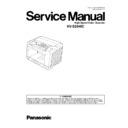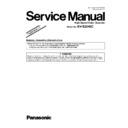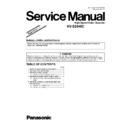Read Panasonic KV-S2048C Service Manual online
Order Number KM70609207CE
Category Number G14
High Speed Color Scanner
KV-S2048C
2
TABLE OF CONTENTS
PAGE
PAGE
1 GENERAL PRECAUTIONS -------------------------------------3
1.1. Safety Precautions-----------------------------------------3
1.2. Electrical Tests ----------------------------------------------3
1.3. For Service Technicians ----------------------------------3
1.4. About Lead Free Solder (PbF: Pb free) --------------4
1.5. About RoHS -------------------------------------------------4
1.2. Electrical Tests ----------------------------------------------3
1.3. For Service Technicians ----------------------------------3
1.4. About Lead Free Solder (PbF: Pb free) --------------4
1.5. About RoHS -------------------------------------------------4
2 SPECIFICATIONS -------------------------------------------------5
3 COMPONENT IDENTIFICATION ------------------------------7
4 INSTALLATION-----------------------------------------------------8
3 COMPONENT IDENTIFICATION ------------------------------7
4 INSTALLATION-----------------------------------------------------8
4.1. Minimum Space Requirements -------------------------8
4.2. Connecting the Scanner to a Personal
4.2. Connecting the Scanner to a Personal
Computer-----------------------------------------------------9
4.3. System Requirements ---------------------------------- 10
5 SECTIONAL VIEWS--------------------------------------------- 11
5.1. CIS (Contact Image Sensor) -------------------------- 11
5.2. Rollers------------------------------------------------------- 12
5.3. Circuit Boards --------------------------------------------- 13
5.4. Sensor Boards and Switch ---------------------------- 14
5.2. Rollers------------------------------------------------------- 12
5.3. Circuit Boards --------------------------------------------- 13
5.4. Sensor Boards and Switch ---------------------------- 14
6 MECHANICAL FUNCTION ------------------------------------ 15
6.1. Feed Mechanism ----------------------------------------- 15
7 MAINTENANCE -------------------------------------------------- 16
7.1. Maintenance Chart--------------------------------------- 16
7.2. Cleaning ---------------------------------------------------- 16
7.3. Replacing Limited Life Parts--------------------------- 24
7.2. Cleaning ---------------------------------------------------- 16
7.3. Replacing Limited Life Parts--------------------------- 24
8 DISASSEMBLY INSTRUCTIONS---------------------------- 30
8.1. Disassembly Flowchart --------------------------------- 30
8.2. Exterior------------------------------------------------------ 32
8.3. Unit Components----------------------------------------- 39
8.4. Circuit Board Assemblies ------------------------------ 52
8.2. Exterior------------------------------------------------------ 32
8.3. Unit Components----------------------------------------- 39
8.4. Circuit Board Assemblies ------------------------------ 52
9 SERVICE UTILITY & SELF TEST --------------------------- 59
9.1. Main Menu Indication for Service Utility ------------ 59
9.2. Function Item List of Service Utility------------------ 60
9.3. Operation--------------------------------------------------- 61
9.4. Scanner Self-test ----------------------------------------- 70
9.2. Function Item List of Service Utility------------------ 60
9.3. Operation--------------------------------------------------- 61
9.4. Scanner Self-test ----------------------------------------- 70
10 TROUBLESHOOTING ------------------------------------------ 71
10.1. Troubleshooting-1 (with no error message on
PC)----------------------------------------------------------- 71
10.2. Troubleshooting-2 (according to Error Code or
Scanner Status in Service Utility) -------------------- 72
10.3. Requirement After Parts Replacement ------------- 84
11 CIRCUIT DESCRIPTION --------------------------------------- 85
11.1. Block Diagram -1 (Image Processing) -------------- 85
11.2. Block Diagram-2 (Board) ------------------------------- 86
11.3. Explanation of Connector ------------------------------ 87
11.2. Block Diagram-2 (Board) ------------------------------- 86
11.3. Explanation of Connector ------------------------------ 87
12 SCHEMATIC DIAGRAM---------------------------------------- 94
12.1. CONTROL Board ---------------------------------------- 95
12.2. POWER Board, POWER SW Board -------------- 107
12.3. Sensors (Others) ----------------------------------------110
12.2. POWER Board, POWER SW Board -------------- 107
12.3. Sensors (Others) ----------------------------------------110
13 CIRCUIT BOARDS -------------------------------------------- 112
13.1. CONTROL Board ---------------------------------------113
13.2. POWER Board-------------------------------------------115
13.3. POWER SW Board -------------------------------------116
13.4. STARTING POSITION SENSOR Board ----------116
13.5. WAITING SENSOR Board----------------------------116
13.6. ENDING SENSOR Board-----------------------------116
13.7. RELAY (FRONT) Board -------------------------------116
13.8. RELAY (BACK) Board ---------------------------------117
13.9. LED Board ------------------------------------------------117
13.2. POWER Board-------------------------------------------115
13.3. POWER SW Board -------------------------------------116
13.4. STARTING POSITION SENSOR Board ----------116
13.5. WAITING SENSOR Board----------------------------116
13.6. ENDING SENSOR Board-----------------------------116
13.7. RELAY (FRONT) Board -------------------------------116
13.8. RELAY (BACK) Board ---------------------------------117
13.9. LED Board ------------------------------------------------117
13.10. DOUBLE FEED DETECTOR (G) Board ---------- 117
13.11. DOUBLE FEED DETECTOR (R) Board ---------- 117
14 PARTS LOCATION AND MECHANICAL PARTS
LIST ---------------------------------------------------------------- 118
14.1. Exterior ---------------------------------------------------- 119
14.2. Chassis and Base --------------------------------------121
14.3. Hopper Unit ----------------------------------------------124
14.4. Power Unit------------------------------------------------ 127
14.5. Packing----------------------------------------------------128
14.6. Tool ---------------------------------------------------------129
14.2. Chassis and Base --------------------------------------121
14.3. Hopper Unit ----------------------------------------------124
14.4. Power Unit------------------------------------------------ 127
14.5. Packing----------------------------------------------------128
14.6. Tool ---------------------------------------------------------129
15 REPLACEMENT PARTS LIST ------------------------------130
15.1. CONTROL Board--------------------------------------- 130
15.2. POWER Board ------------------------------------------136
15.3. POWER SW Board-------------------------------------137
15.4. STARTING POSITION SENSOR Board ----------137
15.5. WAITING SENSOR Board ---------------------------137
15.6. ENDING SENSOR Board ----------------------------138
15.7. RELAY (FRONT) Board------------------------------- 138
15.8. RELAY (BACK) Board ---------------------------------138
15.9. LED Board------------------------------------------------ 138
15.2. POWER Board ------------------------------------------136
15.3. POWER SW Board-------------------------------------137
15.4. STARTING POSITION SENSOR Board ----------137
15.5. WAITING SENSOR Board ---------------------------137
15.6. ENDING SENSOR Board ----------------------------138
15.7. RELAY (FRONT) Board------------------------------- 138
15.8. RELAY (BACK) Board ---------------------------------138
15.9. LED Board------------------------------------------------ 138
15.10. DOUBLE FEED DETECTOR (G) Board ----------139
15.11. DOUBLE FEED DETECTOR (R) Board ----------139
3
1 GENERAL PRECAUTIONS
1.1.
Safety Precautions
1. Before servicing, unplug the power cord to prevent electrical shock hazard.
2. When replacing parts, use only manufacture’s recommended components for safety.
3. Check the condition of power cord. Replace if wear or damage is evident.
4. After servicing, be sure to restore the wire dressing, insulation barriers, insulation papers, shields, etc.
2. When replacing parts, use only manufacture’s recommended components for safety.
3. Check the condition of power cord. Replace if wear or damage is evident.
4. After servicing, be sure to restore the wire dressing, insulation barriers, insulation papers, shields, etc.
5. Before returning the serviced equipment to the customer, perform the following electrical tests to prevent shock hazard.
1.2.
Electrical Tests
1. Unplug the power cord and check for continuity between the earth ground connection on the plug and the metal cabinet.
There should be zero ohm resistance found.
2. With the unit unplugged, short the AC Live-Neutral of the plug with a jumper wire.
3. Turn ON the power switch.
4. Measure the resistance value with an ohmmeter between the jumpered AC plug and each exposed metal cabinet part, such
3. Turn ON the power switch.
4. Measure the resistance value with an ohmmeter between the jumpered AC plug and each exposed metal cabinet part, such
as screwheads, etc.
Note
Note
Some exposed parts may be isolate from the chassis by design. They read infinity.
5. If the measurement is less than 1 M
Ω
, a possibility for electric shock may exit.
Note
This hazardous condition must be corrected before the unit is returned to the end user.
1.3.
For Service Technicians
ICs and LSIs are vulnerable to static electricity.
When repairing, the following precautions will help to prevent recurring malfunctions.
When repairing, the following precautions will help to prevent recurring malfunctions.
1. Cover the plastic parts with aluminum foil.
2. Ground the soldering irons.
3. Use a conductive mat on the worktable.
4. Do not grasp IC or LSI pins with bare fingers.
2. Ground the soldering irons.
3. Use a conductive mat on the worktable.
4. Do not grasp IC or LSI pins with bare fingers.
4
1.4.
About Lead Free Solder (PbF: Pb free)
Note
• In the information below, Pb, the symbol for lead in the periodic table of elements, will refer to standard solder or solder
that contains lead.
• We will use PbF when discussing the lead free solder used in our manufacturing process which is made from Tin (Sn),
Silver (Ag), and Copper (Cu).
• This model, and others like it, manufactured using lead free solder will have PbF stamped on the PCB. For service and
repair work we suggest using the same type of solder.
Distinction of PbF PCB
• PCBs (manufactured) using lead free solder will have a PbF stamp on the PCB.
Caution
• PbF solder has a melting point that is 50
°
- 70
°
F, (30
°
- 40
°
C) higher than Pb solder.
Please use a soldering iron with temperature control and adjust it to 700
°
± 20
°
F (370
°
± 10
°
C).
• Exercise care while using higher temperature soldering irons.: Do not heat the PCB for too long time in order to
prevent solder splash or damage to the PCB.
• PbF solder will tend to splash if it is heated much higher than its melting point, approximately 1100
°
F, (600
°
C).
• When applying PbF solder to double layered boards, please check the component side for excess solder which may
flow onto the opposite side (See figure below)
1.4.1.
Suggested Pb free solder
We recommend you to use the following solder when re-soldering components for repair. Before using other Pb free solder than the
following solder, make sure to confirm that the solder maker (you use) has the license agreement for Pb free solder.
following solder, make sure to confirm that the solder maker (you use) has the license agreement for Pb free solder.
Supplier: Senju Metal Industry Co., Ltd. (http://www.senju-m.co.jp)
Part Description in Senju: EcoSolder RMA02 P3 M705 Series
Part Description in Senju: EcoSolder RMA02 P3 M705 Series
1.5.
About RoHS
This product is fully compliant with the national laws transposed from the EU Directive on the restriction of the use of certain
hazardous substances (RoHS) in electrical and electronic equipment, effective 1st July 2006 in the EU countries.
hazardous substances (RoHS) in electrical and electronic equipment, effective 1st July 2006 in the EU countries.
In order for the product to comply with the RoHS Directive, the six particular substances (lead, mercury, cadmium, hexavalent
chromium, polybrominated biphenyls, and polybrominated diphenyl ethers) have been either totally eliminated or limited to the
concentration level below maximum allowed. Consequently spare parts have been changed to RoHS-compliant parts where
applicable.
chromium, polybrominated biphenyls, and polybrominated diphenyl ethers) have been either totally eliminated or limited to the
concentration level below maximum allowed. Consequently spare parts have been changed to RoHS-compliant parts where
applicable.
Due to spare parts application of RoHS legislation, non-compliant spare parts cannot be used to repair compliant products put on
the EU market on or after 1st July 2006. Please therefore make sure to order and use RoHS-compliant spare parts listed in this
manual.
the EU market on or after 1st July 2006. Please therefore make sure to order and use RoHS-compliant spare parts listed in this
manual.



